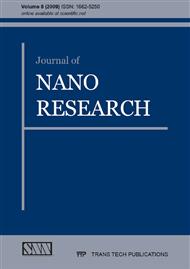[1]
J.W. Edington: Pratical Electron Microscopy in materials science (Oxford University Press, New York, 1976).
Google Scholar
[2]
P. Hawkes: Magnetic Electron Lenses (Springer Verlag, New York, 1982).
Google Scholar
[3]
D.B. Williams and C.B. Carter: Transmission Electron Microscopy. A Textbook for Materials Science (Plenum Press, New York and London, 1996). Figure 6 The experimental value of A/B is 1. 15 and those of α and β are 65° and 50°, respectively. These values are in rough agreement with the.
Google Scholar
[12]
zone axis diffraction of a cubic structure. The calculated lattice spacings of (200) and (211) planes are 2. 4 and 2. 1 Å. These are roughly in consistent with the lattice spacings of Ag2O (d200=2. 38 Å; d211=1. 94 Å), which has a primitive cubic lattice. Figure 5 Bright field image of a 9th century lusterware (Sue) with the comparison of EEL spectrum of Cu-L edges of one nanoparticles with references EEL spectra.
Google Scholar
[4]
J. Ayache, L. Beaunier, J. Boumendil, G. Ehret and D. Laub: Guide de préparation des échantillons pour la microscopie électronique en transmission, tome 2 (PUSE, Saint-Etienne, 2007).
Google Scholar
[5]
L.A. Giannuzzi and F.A. Stevie: Micron Vol. 30 (1999), p.197.
Google Scholar
[6]
D.S. McPhail, R.J. Chater and L. Li: Microchimica Acta Vol. 161 (2008), p.387.
Google Scholar
[7]
M.W. Phaneuf: Micron Vol. 30 (1999), p.277.
Google Scholar
[8]
D. Bleiner, M. Macrì, P. Gasser, V. Sautter and A. Maras: Talanta Vol. 68 (2006), p.1623.
Google Scholar
[9]
R. Wirth: Chemical Geology (2008), p. doi: 10. 1016/j. chemgeo. 2008. 05. 05. 019.
Google Scholar
[10]
K. Tsujimoto and M. Kitada: Journal of the Japan Institute of Metals Vol. 68 (2004), p.311.
Google Scholar
[11]
R. Haswell, U. Zeile and K. Mensch: Microchimica Acta Vol. 161 (2008), p.363.
Google Scholar
[12]
M.S. Tite: Archaeometry Vol. 50 (2008), p.216.
Google Scholar
[13]
R.F. Egerton: Electron Energy-Loss Spectroscopy in The Electron Microscope (Plenum Press, New York, 1996).
Google Scholar
[14]
O.L. Krivanek, A.J. Gubbens, N. Dellby and C.E. Meyer: Microscopy Microanalysis Microstructures Vol. 3 (1992), p.187.
Google Scholar
[15]
C. Colliex, M. Tence, E. Lefevre, C. Mory, H. Gu, D. Bouchet and J. C.: Mikrochimica Acta Vol. 114 (1994), p.71.
Google Scholar
[16]
M.A. Marcus, A.J. Westphal and S.C. Fakra: Journal of Synchrotron Radiation Vol. 15 (2008), p.463.
Google Scholar
[17]
P. Sciau, S. Relaix, C. Roucau and Y. Kihn: Journal of the American Ceramic Society Vol. 89 (2006), p.1053.
Google Scholar
[18]
A. Gomez-Herrero, E. Urones-Garrote, A.J. Lopez and L.C. Otero-Diaz: Applied Physics A: Materials Science & Processing Vol. 92 (2008), p.97.
Google Scholar
[19]
C. Mirguet, C. Dejoie, C. Roucau, P. de Parseval, S.J. Teat and P. Sciau: Archaeometry (2009), p. (to be published).
DOI: 10.1111/j.1475-4754.2008.00452.x
Google Scholar
[20]
Ph. Colomban: Journal of nano Research, in this Cultural Heritage Special Issue.
Google Scholar
[21]
J. Pérez-Arantegui, J. Molera, A. Larrea, T. Pradell, M. Vendrell-Saz, I. Borgia, B.G. Brunetti, F. Cariati, P. Fermo, M. Mellini, A. Sgamellotti and C. Vitti: Journal of the American Ceramic Society Vol. 84 (2001), p.442.
DOI: 10.1111/j.1151-2916.2001.tb00674.x
Google Scholar
[22]
P. Fredrickx, D. Hélary, D. Schryvers and E. Darque-Ceretti: Applied Physics A: Materials Science & Processing Vol. 79 (2004), p.283.
DOI: 10.1007/s00339-004-2515-3
Google Scholar
[23]
J. Roqué, J. Molera, P. Sciau, E. Pantos and A. Vendrell-Saz: Journal of the European Ceramic Society Vol. 26 (2006), p.3813.
DOI: 10.1016/j.jeurceramsoc.2005.12.024
Google Scholar
[24]
J. Roqué, J. Molera, J. Pérez-Arantegui, C. Calabuig, J. Portillo and M. Vendrell-Saz: Archaeometry Vol. 49 (2007), p.511.
DOI: 10.1111/j.1475-4754.2007.00317.x
Google Scholar
[25]
C. Mirguet, P. Fredrickx, P. Sciau and P. Colomban: Phase Transitions Vol. 81 (2008), p.253.
Google Scholar
[26]
D. Chabanne, O. Bobin, M. Schvoerer, C. Ney and P. Sciau, Metallic lustre of glazed ceramics: evolution of decorations, in: I.F. e. Catolico» (Ed. ), 34h International Symposium on Archaeometry, Institucion «Fernando el Catolico» ed., Institucion «Fernando el Catolico», Zaragoza, 2006, p.427.
DOI: 10.1017/s0395264900074497
Google Scholar
[27]
J.P. Ngantcha, M. Gerland, Y. Kihn and A. Rivière: The European Physical Journal Applied Physics Vol. 29 (2005), p.83.
Google Scholar
[28]
S. Padovani, D. Puzzovio, P. Mazzoldi, I. Borgia, A. Sgamellotti, B.G. Brunetti, L. Cartechini, F. D'Acapito, C. Maurizio, F. Shokouhi, P. Oliaiy, J. Rahighi, M. Lamehi-Rachti and E. Pantos: Applied Physics A: Materials Science & Processing Vol. 83 (2006).
DOI: 10.1007/s00339-006-3558-4
Google Scholar


